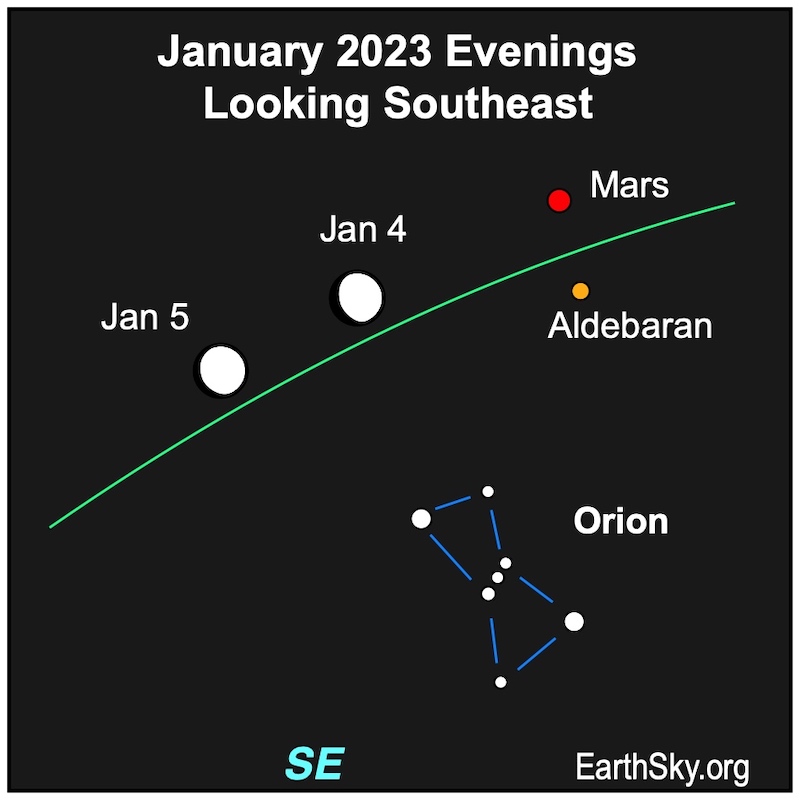
Moon near Orion and Mars
On the evenings of January 4 and 5, 2023, from the Northern Hemisphere, the nearly full moon will be almost overhead. Orion the Hunter stands above the southern horizon: Look above his raised club to see the moon presiding over all.
The moon is leaving Taurus the Bull and bright Mars behind, headed for Gemini the Twins and its bright stars Castor and Pollux. On both January 4 and 5, the moon will be more than 90% lit, shining brightly over the landscape below, and in many places illuminating winter snow.
The waxing gibbous moon won’t reach full phase and 100% lit until 23:08 UTC (5:08 p.m. CST) on January 6, 2023. The Wolf Moon will probably not be noticeably smaller to your eye, but the full moon this month is a micromoon, because it’s getting close to its far point in its orbit around Earth.
The view from the Southern Hemisphere
If you’re in the Southern Hemisphere, Orion the Hunter stands on his head above the northern horizon. Instead of the moon being high overhead, like in the Northern Hemisphere, the moon is hugging the horizon. That’s because the path of the full moon in early January mimics that of the June sun. And for those in summer in June, the sun is high, while those in winter in June have a sun lower to the horizon. The moon’s path roughly follows the sun’s daytime path from six months ago, and six months from now.
So, depending on your location on Earth, the view of the night sky changes slightly. If you’re in the Southern Hemisphere, turn our maps upside down for a more accurate view. Or try Stellarium for a precise star chart from your location.
Bottom line: See the nearly full moon near Orion the Hunter, a hallmark of January skies. Bright, reddish Mars is nearby in the constellation Taurus the Bull.
For more great observing events in the coming weeks, visit EarthSky’s night sky guide
The post Nearly full moon near Orion, January 4 and 5 first appeared on EarthSky.
from EarthSky https://ift.tt/VwC3gxM

Moon near Orion and Mars
On the evenings of January 4 and 5, 2023, from the Northern Hemisphere, the nearly full moon will be almost overhead. Orion the Hunter stands above the southern horizon: Look above his raised club to see the moon presiding over all.
The moon is leaving Taurus the Bull and bright Mars behind, headed for Gemini the Twins and its bright stars Castor and Pollux. On both January 4 and 5, the moon will be more than 90% lit, shining brightly over the landscape below, and in many places illuminating winter snow.
The waxing gibbous moon won’t reach full phase and 100% lit until 23:08 UTC (5:08 p.m. CST) on January 6, 2023. The Wolf Moon will probably not be noticeably smaller to your eye, but the full moon this month is a micromoon, because it’s getting close to its far point in its orbit around Earth.
The view from the Southern Hemisphere
If you’re in the Southern Hemisphere, Orion the Hunter stands on his head above the northern horizon. Instead of the moon being high overhead, like in the Northern Hemisphere, the moon is hugging the horizon. That’s because the path of the full moon in early January mimics that of the June sun. And for those in summer in June, the sun is high, while those in winter in June have a sun lower to the horizon. The moon’s path roughly follows the sun’s daytime path from six months ago, and six months from now.
So, depending on your location on Earth, the view of the night sky changes slightly. If you’re in the Southern Hemisphere, turn our maps upside down for a more accurate view. Or try Stellarium for a precise star chart from your location.
Bottom line: See the nearly full moon near Orion the Hunter, a hallmark of January skies. Bright, reddish Mars is nearby in the constellation Taurus the Bull.
For more great observing events in the coming weeks, visit EarthSky’s night sky guide
The post Nearly full moon near Orion, January 4 and 5 first appeared on EarthSky.
from EarthSky https://ift.tt/VwC3gxM

Aucun commentaire:
Enregistrer un commentaire